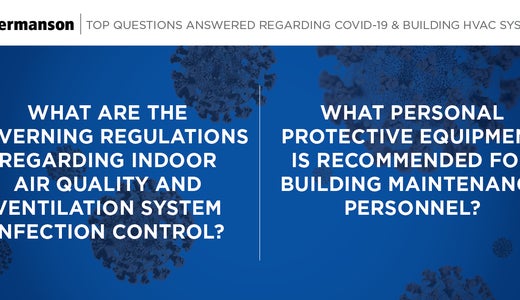
In response to COVID-19, on March 17th, Hermanson’s Brad Sharp, TAB/Commissioning/Controls Manager was part of a webinar hosted by BOMA Seattle-King County and viewed by over 800 individuals that featured a panel of experts in public health, building maintenance, property management, and legal services. You can listen to the webinar here.
Since his participation in the webinar, Brad has been fielding calls from area Mayors, Governors, and public and private healthcare policy makers about indoor air quality and ventilation system infection control. Over the next several days, Hermanson will be offering a deeper dive into this important issue by posting a series of the questions and responses that are on the minds of building owners, managers and maintenance personnel across the country.
Today’s question establishes the basis for best practices and outlines the agencies doing the research to create them. Follow along as Brad discusses the role of filtration, air circulation, the risk to maintenance personnel and offers best practices to help mitigate infection control.
There currently is no code, only standards and best practices developed by several interconnected agencies, including:
ASHRAE (American Society of Heating, Refrigerating and Air-Conditioning Engineers) focusing on building systems, energy efficiency, indoor air quality, refrigeration and sustainability within the industry through research, standards writing, publishing and continuing education. ASHRAE’s standards on Filtration can be found at ASHRAE 62.1 Page 15, Section 6.1.4.2 MERV 11 required for particulate matter smaller than 2.5 Micrometers.
NAFA (National Air Filtration Association) publishes a series of air filtration best practice guidelines based on uniform building codes. Going beyond the minimum standard threshold, their recommendations incorporate the “highest level of air filtration standards” for specific applications.
FGI (Facility Guidelines Institute) is an independent, not-for-profit organization dedicated to developing guidance for the planning, design, and construction of healthcare facilities and disseminating that information through publication of Guidelines for Design and Construction and other practical, evidence-informed publications.

Based on Hermanson’s years of experience and the guidance of industry recognized standards and best practices, Hermanson’s Brad Sharp, CHC with assistance from Hermanson Senior Engineer, Pedro Alicea, are offering a series of posts to provide practical responses based on years of experience and the guidance of industry recognized standards and best practices set for by ASHRAE, NAFA, FGI, and OSHA.
NAFA (National Air Filtration Association) recommends that all building maintenance personnel involved in the work of changing out air filters should be outfitted with a full array of PPE (personal protection equipment) which includes:
- Eye Protection
- Properly Fitted Face Mask (rated N95 or greater)
- Gloves
- Overalls
OSHA Regulations can be found here:
https://www.facilitiesnet.com/maintenanceoperations/article/OSHA-Regulations-for-Personal-Protective-Equipment--11524
Per the Centers for Disease Control and Prevention (CDC), maintenance staff performing maintenance and filter replacement on any ventilation system that is likely to be contaminated with hazardous agents should wear appropriate personal protective equipment (respirators, gloves, etc.) in accordance with Occupational Safety and Health Administration (OSHA) standards 29 Code of Federal Regulations (CFR) 1910.133 thru 138.
Handling and decontaminating filters exposed requires knowledge of the hazards, safety-related information concerning the decontaminating compounds, and proper hazardous waste disposal procedures.
The (CDC) recommends NIOSH-approved 95% efficient non-oil mist environment (N95) respirators and gloves for a worker performing filter maintenance in a health care setting where the spread of disease is a concern. Maintenance and filter change-out should be performed only when a system is shut down to avoid re-entrainment and system exposure.
Where feasible, particulate filters may be disinfected in a 10% bleach solution or other appropriate biocide before removal. Note: When using disinfecting compounds, the HVAC systems should be shut down and care should be taken to ensure that the compounds are compatible with the HVAC system components they may contact. Place old filters in sealed plastic bags upon removal.
More information can be found on the CDC website: https://www.cdc.gov/niosh/docs/2003-136/pdfs/2003-136.pdf
And as always, licensed professional mechanical contractors, like Hermanson, are available to assist with filter changes and other building needs. As justified, continue with regularly scheduled HVAC system maintenance.
-----------------------------
The responses offered in this post are based on findings of industry recognized standards and best practices developed by ASHRAE, NAFA, CDC, OSHA and FGI. They are offered as guidelines and do not account for the specifics of any building or its mechanical systems. For specific information as to a given building or system, please contact Hermanson or a licensed mechanical engineer. Any actions taken based on the responses given are the sole responsibility of the party taking such actions.



